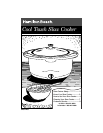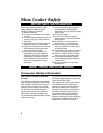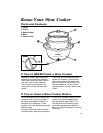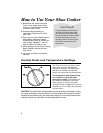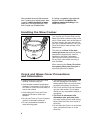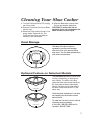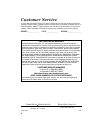
6
• Please handle the Crock and Cover
carefully to ensure long life.
• Avoid sudden, extreme temperature
changes. For example, do not place a
hot Cover or Crock into cold water, or
onto a wet surface.
• Avoid hitting the Crock and Cover
against the faucet or other hard
surfaces.
• Do not use Crock or Cover if chipped,
cracked, or severely scratched.
• Do not use abrasive cleansers or
metal scouring pads.
Crock and Glass Cover Precautions
and Information
• The bottom of the Crock is very rough
and can damage the countertop.
Always place Crock on a mat or trivet
to protect countertop. Use caution.
• The Crock and the Cover can become
very hot. Use caution. Do not place
directly on any unprotected surface or
countertop.
• The Crock is microwave safe,
dishwasher safe, and oven proof,
but never heat the Crock when empty.
Never place the Crock on a burner or
stove top.
• Do not place the Cover in a microwave
oven, conventional oven, or on the
stove top.
The Handles and Control Knob on the
Base of the slow cooker are cool to the
touch. Other areas, such as the Base of
the slow cooker, are warm but will not
burn you if casually touched. The Crock,
Cover and interior metal surface of the
Base are hot.
The sides of the Base of the slow
cooker get warm because the heating
elements are located here. Use the
handles on the Base if necessary.
Use hot mitts to remove the Crock or
let the Crock cool before removing it
from the Base.
When removing the Cover, tilt so that
the opening faces away from you to
avoid being burned by steam.
Handling the Slow Cooker
Slow cookers have very little evapora-
tion. If making your favorite soup, stew,
or sauce, reduce the liquid or water
called for in the original recipe. If too
thick, liquids can be added later.
If cooking a vegetable-type casserole,
there will need to be liquid in the
recipe to prevent scorching on the
sides of the Crock.



